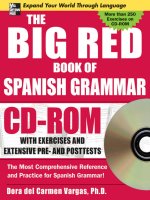the big red book of spanish grammar
Bạn đang xem bản rút gọn của tài liệu. Xem và tải ngay bản đầy đủ của tài liệu tại đây (2.23 MB, 514 trang )
THE
BIG RED
BOOK OF
SPANISH GRAMMAR
Also in this series:
Gordon, Stillman, e Big Red Book of Spanish Verbs
Gordon, Stillman, e Big Red Book of Spanish Verbs with CD-ROM
omas, omas, Nash, Richmond, e Big Red Book of Spanish
Vocabulary
Stillman, Gordon, e Big Blue Book of French Verbs
Stillman, Gordon, e Big Blue Book of French Verbs with CD-ROM
Listen, Di Donato, Franklin, e Big Yellow Book of German Verbs
Listen, Di Donato, Franklin, e Big Yellow Book of German Verbs
with CD-ROM
Maes-Christie, Franklin, e Big Green Book of Italian Verbs
Maes-Christie, Saggese, Franklin, e Big Green Book of Italian Verbs
with CD-ROM
Franke, e Big Silver Book of Russian Verbs
Betts, Franklin, e Big Gold Book of Latin Verbs
THE
BIG RED
BOOK OF
SPANISH GRAMMAR
Dora del Carmen Vargas, Ph.D.
New York Chicago San Francisco Lisbon London Madrid Mexico City
Milan New Delhi San Juan Seoul Singapore Sydney Toronto
Copyright © 2008 by The McGraw-Hill Companies, Inc. All rights reserved. Manufactured in the United States of America.
Except as permitted under the United States Copyright Act of 1976, no part of this publication may be reproduced or
distributed in any form or by any means, or stored in a database or retrieval system, without the prior written permission of
the publisher.
0-07-154761-4
The material in this eBook also appears in the print version of this title: 0-07-154758-4.
All trademarks are trademarks of their respective owners. Rather than put a trademark symbol after every occurrence of a
trademarked name, we use names in an editorial fashion only, and to the benefit of the trademark owner, with no intention
of infringement of the trademark. Where such designations appear in this book, they have been printed with initial caps.
McGraw-Hill eBooks are available at special quantity discounts to use as premiums and sales promotions, or for use in
corporate training programs. For more information, please contact George Hoare, Special Sales, at george_hoare@
mcgraw-hill.com or (212) 904-4069.
TERMS OF USE
This is a copyrighted work and The McGraw-Hill Companies, Inc. (“McGraw-Hill”) and its licensors reserve all rights in
and to the work. Use of this work is subject to these terms. Except as permitted under the Copyright Act of 1976 and the
right to store and retrieve one copy of the work, you may not decompile, disassemble, reverse engineer, reproduce, modify,
create derivative works based upon, transmit, distribute, disseminate, sell, publish or sublicense the work or any part of it
without McGraw-Hill’s prior consent. You may use the work for your own noncommercial and personal use; any other use
of the work is strictly prohibited. Your right to use the work may be terminated if you fail to comply with these terms.
THE WORK IS PROVIDED “AS IS.” McGRAW-HILL AND ITS LICENSORS MAKE NO GUARANTEES OR WAR-
RANTIES AS TO THE ACCURACY, ADEQUACY OR COMPLETENESS OF OR RESULTS TO BE OBTAINED FROM
USING THE WORK, INCLUDING ANY INFORMATION THAT CAN BE ACCESSED THROUGH THE WORK VIA
HYPERLINK OR OTHERWISE, AND EXPRESSLY DISCLAIM ANY WARRANTY, EXPRESS OR IMPLIED,
INCLUDING BUT NOT LIMITED TO IMPLIED WARRANTIES OF MERCHANTABILITY OR FITNESS FOR A
PARTICULAR PURPOSE. McGraw-Hill and its licensors do not warrant or guarantee that the functions contained in the
work will meet your requirements or that its operation will be uninterrupted or error free. Neither McGraw-Hill nor its licen-
sors shall be liable to you or anyone else for any inaccuracy, error or omission, regardless of cause, in the work or for any
damages resulting therefrom. McGraw-Hill has no responsibility for the content of any information accessed through the
work. Under no circumstances shall McGraw-Hill and/or its licensors be liable for any indirect, incidental, special,
punitive, consequential or similar damages that result from the use of or inability to use the work, even if any of them has
been advised of the possibility of such damages. This limitation of liability shall apply to any claim or cause whatsoever
whether such claim or cause arises in contract, tort or otherwise.
DOI: 10.1036/0071547584
We hope you enjoy this
McGraw-Hill eBook! If
you’d like more information about this book,
its author, or related books and websites,
please click here.
Professional
Want to learn more?
v
Contents
1. Articles 1
Defi nite Article Forms Uses of the Indefi nite Article
Uses of the Defi nite Article The Neuter Article lo
Indefi nite Article Forms
2. Nouns 30
Gender of Nouns Collective Nouns
Number of Nouns Uses of Nouns
Compound Nouns Agreement of Nouns
3. The Present Indicative 62
Regular Verbs in the Present Tense Verbs like gustar
Irregular Verbs in the Present Tense Uses of the Present Indicative
Refl exive Verbs The Verbs ser and estar
4. Adjectives 84
Classifi cation of Adjectives Numerals
Descriptive Adjectives Indefi nite Adjectives
Comparative and Superlative Forms Interrogative and Exclamatory
Demonstrative Adjectives Adjectives
Possessive Adjectives
For more information about this title, click here
CONTENTSvi CONTENTS
5. The Future Tense 192
The Informal Future The Future Perfect Tense
The Simple Future
6. The Preterit Tense 200
Preterit Endings for Regular Verbs Uses of the Preterit Tense
Irregular Preterit Forms Verbs That Change Their Meaning in
Changes in the Verb Stem in the Preterit
the Preterit Contrasts Between the Preterit Tense
Changes in the Endings in and the Imperfect Tense
the Preterit
7. The Imperfect Tense 213
Regular Verbs in the Imperfect Typical Expressions That Trigger
Irregular Verbs in the Imperfect the Imperfect Tense
Uses of the Imperfect Tense
8. The Conditional Tense 218
Regular Forms of the Conditional The Conditional Perfect Tense
Tense Uses of the Conditional Perfect
Irregular Stem Forms Tense
Uses of the Conditional Tense
9. The Present Participle 226
Endings of the Present Participle Uses of the Present Participle
Stems of the Present Participle
10. The Past Participle 235
Forms of the Past Participle Uses of the Past Participle
CONTENTS viiCONTENTS
11. The Present Perfect Indicative 241
Forms of the Present Perfect Tense Uses of the Present Perfect Tense
12. The Past Perfect Indicative 244
Forms of the Past Perfect Tense Uses of the Past Perfect Tense
13. The Infinitive 248
Uses of the Infi nitive
14. The Subjunctive 259
Elements of a Subjunctive Sentence The Present Subjunctive
Structure of a Subjunctive Sentence The Imperfect Subjunctive
Verbs That Trigger the Subjunctive The Present Perfect Subjunctive
in the Dependent Clause The Pluperfect Subjunctive
15. The Imperative 291
The Ud. and Uds. Formal Commands The Impersonal Commands
The tú Informal or Familiar Commands Expressed with the
Commands Present Tense
The Plural of the tú Informal Commands Expressed with the
Command Future Tense
The First Person Plural nosotros
Commands (Let’s Commands)
16. Pronouns 315
Personal (Subject) Pronouns Possessive Pronouns
Direct Objects and Direct Object Relative Pronouns
Pronouns Interrogative Pronouns
Indirect Objects and Indirect Object Indefi nite Pronouns
Pronouns Refl exive Pronouns
Demonstrative Pronouns Constructions with se
CONTENTSviii CONTENTS
17. Prepositions 401
Simple Prepositions Functions of Prepositions
Simple Prepositions in Compound General Notes on Preposition Usage
Words Uses of Specifi c Prepositions
Compound Prepositions
18. Adverbs 435
Classifi cation of Adverbs Adverbial Complements
Uses of Adverbs Adverbial Phrases
Position of Adverbs Functions of Adverbs
19. Conjunctions 455
Coordinating Conjunctions Subordinating Conjunctions
20. Interjections 463
Categories of Interjections
Appendix 466
Appendix A Accents Appendix D Sample Conjugations
Appendix B Classifi cation of Words with the Pronoun vos
Appendix C Division of Words into Appendix E Punctuation
Syllables
Index 495
1
1
Articles
Articles are words used before nouns, or before words that function as nouns, to
indicate their gender and number. ey also indicate whether the noun is known to
the reader or the listener (defi nite article) or if it is unknown (indefi nite article). In
Spanish there is also a neuter article, lo, which refers to abstract nouns and does not
point to gender or number.
Definite Article Forms
e English defi nite article the has four equivalent forms in Spanish: el, la, los,
and las.
Singular Plural
masculine: el barco the boat masculine: los barcos the boats
feminine: la sierra the hill feminine: las sierras the hills
Article-Noun Agreement
A.
The definite article agrees in gender and number with the noun to which it refers:
Los autos japoneses son muy populares. Japanese cars are very popular.
Quiero visitar las ruinas de Machu Picchu. I want to visit the ruins of Machu Picchu.
However, there are some exceptions when the noun is singular but has a plural
form:
el paraguas the umbrella los paraguas the umbrellas
el botones the bellboy los botones the bellboys
Copyright © 2008 by The McGraw-Hill Companies, Inc. Click here for terms of use.
THE BIG RED BOOK OF SPANISH GRAMMAR2
B.
The definite article does not agree in gender with singular feminine nouns that begin with
a stressed a or ha, for the sake of euphony:
el águila eagle el agua water el hambre hunger
el alma soul el arpa harp el aula classroom
If the a or ha is unstressed, the feminine defi nite article must be used:
la araña spider la amapola poppy la aduana customs
NOTES:
(1) is apparent masculine article is actually a modifi cation of the old form of
the feminine defi nite article, ela, blending the pronunciation of the letter a with
the fi rst vowel of the noun.
(2) e adjectives that modify the preceding nouns follow the normal rules of
agreement. Since the noun is feminine, the adjective needs to be in the feminine
form:
El arpa vieja
El arpa vieja estaba guardada en el sótano. The old harp was stored in the basement.
Los niños ocuparon
el aula
el aula grande y
espaciosa
espaciosa. The children occupied the large and spacious
classroom.
(3) e apparent gender change does not aff ect the plural form of the defi nite
article:
las águilas las aguas las hambres
las almas las arpas las aulas
(4) To name the letters a and h, the feminine defi nite article is still used, although
the a sound is stressed:
La “a” es la primera letra del abecedario. “A” is the fi rst letter of the alphabet.
La “hache” no se pronuncia en español, a “H” is not pronounced in Spanish unless it is
menos que esté precedida de “c”. preceded by “c.”
(5) If an adjective beginning with stressed a is placed between the defi nite article
and the noun, the feminine form of the defi nite article is maintained:
la ácida manzana the sour apple
la amplia habitación the spacious room
(6) In a familiar style, the feminine defi nite article is also used before a feminine
name that begins with stressed a:
la Ana la Águeda la Ángela
ARTICLES 3
Uses of the Definite Article
A.
The definite article with geographical names
1. e defi nite article agrees with the noun in gender and number:
el Mediterráneo la Antártida
el Peñón de Gibraltar la América Latina
el Río de la Plata la Patagonia
el lago Titicaca la Isla de Pascua
2. Before names of countries and large areas or regions, the defi nite article is usu-
ally omitted, although it is frequently used in cases such as the following:
el África la China el Paraguay
la Argentina el Ecuador el Perú
el Asia los Estados Unidos la Siberia
el Brasil el Japón el Uruguay
3. e defi nite article is used when the names of cities and countries are modifi ed
by a complement:
el México moderno la Roma de los Césares
la España de Franco la Rusia de los Zares
4. Naturally, the defi nite article is used when it is part of the name:
Las Vegas La Habana La Paz
B.
The definite article with names of streets, avenues, and parks
e defi nite article is used when the word calle (street), avenida (avenue), or parque
(park) appears as part of the address:
la Avenida 9 de Julio el Parque Centenario
la Quinta Avenida el Parque Central
la Calle 14 el Parque Lezama
Otherwise, it is not used:
Vivo en Larrea 120. I live at Larrea Street.
Corrientes corta la Avenida 9 de Julio. Corrientes Street intersects July th Avenue.
THE BIG RED BOOK OF SPANISH GRAMMAR4
C.
The definite article with names of people
1. e defi nite article is used when a name is preceded by a title:
la señora Juana el doctor Fernández
el profesor Pérez la abogada García
el Papa Pablo VI el general Franco
El señor García es muy bueno. Mr. García is very nice.
e defi nite article is used in indirect speech, when talking about a person:
Vi a la profesora Gómez ayer. I saw Professor Gómez yesterday.
NOTES:
However, the defi nite article is not used:
(1) in direct address:
Buenas tardes, profesor Pérez. Good afternoon, Professor Pérez.
Doctor Fernández, escríbalo, por favor. Dr. Fernández, write it, please.
(2) with doña or don, as in doña Juana or don Carlos. ( e feminine la doña, used
without the name of the person, as in Juan vio a la doña, has a contemptuous or
humorous connotation.)
(3) with religious titles such as San Antonio, Santa Catalina, Fray Luis de León,
Sor Juana Inés de la Cruz, Santo Tomás.
(4) with titles that include either a cardinal or an ordinal number, such as Pío
Doce (Pius XII) or Felipe Segundo (Philip II).
2. e defi nite article is used when a name is preceded by an adjective:
el pobre Sancho (poor Sancho) la vieja Celestina (old Celestina)
3. e defi nite article is used when a name represents the title of a book, a play, or
an opera:
el Hamlet la Aída el Martín Fierro
NOTES:
e defi nite article is not used, however, if
(1) e title does not include the name of a person, as in
Me gustó mucho Rebelde sin causa. I liked Rebel Without a Cause very much.
ARTICLES
(2) e title already has a defi nite article:
Leímos un comentario sobre El hablador. We read a commentary on El hablador.
4. e defi nite article is used when a name denotes someone’s character:
Su amigo se creía el Lorca del club literario. His friend considered himself the Lorca of the
literary club.
5. e defi nite article is used when a name is followed by an epithet:
Juana la Loca Juana the Mad
Lorenzo el Magnífi co Lawrence the Magnifi cent
6. e defi nite article is used when a feminine name is part of a sentence written in
familiar or fi gurative speech:
Miguel se lo dio a la Dora. Michael gave it to Dora.
¿Oíste el discurso de la Hillary? Did you hear Hillary’s speech?
Tuve una clase con la Tortello. I had a class with Mrs. Tortello.
7. e defi nite article is used when a feminine name is used in legal or journalistic
style:
La Fernández declaró no haberlo conocido. Fernández declared that she had not met him.
La Serrano probó que ya había salido del Serrano proved that she had already left work.
trabajo.
8. e defi nite article is used in the masculine plural with a family name.
e defi nite article is used in the masculine plural form with the family name (last
name) to refer to a married couple or to a family including all its members:
Los García no han llegado todavía. The Garcías have not arrived yet.
Los Morales están en la sala. The Morales are in the living room.
9. e defi nite article is not generally used with names of relatives.
(a) In direct or indirect speech, the name never follows papá or mamá, and the
defi nite article is omitted:
Papá, aquí está el café. Dad, here’s the co ee.
Mamá, acompáñame a la tienda. Mom, come with me to the store.
Dile a papá que venga. Tell Dad to come.
5
THE BIG RED BOOK OF SPANISH GRAMMAR6
(b) Sometimes a father-in-law or mother-in-law is addressed as papá or mamá,
with the name added for clarifi cation. Although this is not generally done in
English, a literal translation follows:
Dáselo a Papá Esteban. Give it to Dad Esteban.
Le escribió una carta a mamá María. He wrote a letter to Mom María.
(c) If the relative is tío(a), the defi nite article is omitted in direct speech but may
be used in indirect speech:
Tía Carmen, ven pronto. Aunt Carmen, come soon.
Le dije a la tía Carmen que viniera pronto. I told Aunt Carmen to come soon.
(d) If the relative is abuelo(a), the defi nite article is omitted in direct speech but
is generally used in indirect speech:
Abuela Ana, tráeme los anteojos. Grandma Ana, bring me the glasses.
Dale los anteojos a la abuela Ana. Give the glasses to Grandma Ana.
D.
The definite article in the masculine form with a phrase or a sentence that functions as
a noun:
No me importa
el
el
qué dirán
qué dirán. I don’t care about their opinion.
Le satisface
el
el
que le hayamos dicho la verdad
que le hayamos dicho la verdad. It satisfi es him that we have told him the truth.
El
El
que lo haya dicho
que lo haya dicho, no indica que sepa lo que The fact that he has said it does not indicate
está pasando. that he knows what is going on.
NOTES:
(1) When there is an adjective that functions as a noun, the defi nite article agrees
with the adjective:
Los
interesados
interesados vinieron a la reunión. The interested (parties) came to the meeting.
La
elegida
elegida era muy bonita. The chosen one was very pretty.
(2) If a noun is left out, the defi nite article agrees with the gender and number of
the implied noun (second example sentence below).
La
señora
señora de enfrente es rusa. The lady across the street is Russian.
La de enfrente es rusa. The one across the street is Russian.
E.
The definite article in the masculine form with infinitives that function as nouns
When the infi nitive functions as a noun and is in the position of the subject, it is
preceded by the masculine singular form of the defi nite article:
ARTICLES 7
El
El
ir y venir
ir y venir de la gente era insoportable. The coming and going of the people was
unbearable.
El
El
comer tarde
comer tarde no es bueno para la salud. Eating late is not good for one’s health.
El
El
no contestar mis cartas
no contestar mis cartas me dice que ella no Her not answering (The fact that she doesn’t
está interesada. answer) my letters tells me that she is not
interested.
F.
The definite article with parts of the body
e defi nite article is used in Spanish with parts of the body instead of the possessive
adjective:
Me lastimé la muñeca. I hurt my wrist.
Juan se ha golpeado el codo. Juan has hurt his elbow.
Tiene los pies hinchados. She has swollen feet.
NOTE:
However, in order to emphasize a particular part of the body or to avoid ambi-
guity, the possessive adjective is generally used.
Todavía recuerdo los matices de su pelo. I still remember the shades of her hair.
Mis manos temblaban. My hands were trembling.
G.
The definite article with a noun used in apposition with another noun to give emphasis or
for clarification:
Juan, el hijo de Carlos, terminó sus estudios. Juan, Carlos’s son, fi nished his studies.
Ana, la maestra de secundaria, no gana Ana, the high school teacher, does not make
mucho. much money.
NOTE:
In some cases, the use of the defi nite article indicates individuality:
Carlos, electricista de la fi rma, es mi hermano. Carlos, an electrician in the fi rm, is my
brother. (Carlos is not necessarily the only
electrician there.)
Carlos, el electricista de la fi rma, es mi Carlos, the electrician of the fi rm, is my
hermano. brother. (Carlos is the only electrician in
the company.)
THE BIG RED BOOK OF SPANISH GRAMMAR8
H.
The definite article with a noun used after the conjunction o (or) to indicate an
alternative:
Quiero comprar la falda o la blusa. I want to buy the skirt or the blouse.
NOTE:
However, it is omitted when the noun after o is used as a clarifi cation of the
noun before it:
El inspector o encargado de la investigación The inspector, or head of the investigation,
dio una explicación sobre el material explained about the material that had
desaparecido. disappeared.
I.
The definite article with superlative forms:
La jirafa, el animal más alto, come hojas. The gira e, the tallest animal, eats leaves.
J.
The definite article with pieces of clothing
In Spanish, the defi nite article is used when the possessive adjective would be used in
English:
Delia se puso el vestido nuevo para la fi esta. Delia put on her new dress for the party.
Tienes los zapatos bien lustrados. Your shoes are well polished.
K.
The definite article with days of the week
1. e masculine form of the defi nite article is used with days of the week. Also,
the defi nite article is used in Spanish when the preposition on would be used in
English:
Llegaremos el lunes. We will arrive on Monday.
Tengo clases los martes. I have classes on Tuesdays.
El jueves es un buen día para mí. Thursday is a good day for me.
2. e defi nite article is used after hasta and para:
¡Hasta el martes! See you on Tuesday!
Esto es para el sábado. This is for Saturday.
ARTICLES 9
3. e defi nite article follows the word todos (every):
Visita a su madre todos los martes. He visits his mother every Tuesday.
4. e defi nite article is omitted when the day of the week follows the verb ser to
identify the day:
Hoy es viernes. Today is Friday.
Ayer fue lunes. Yesterday was Monday.
5. e defi nite article is omitted with the expression de a to indicate from . . . to:
Juan trabaja de miércoles a domingo. Juan works from Wednesday to Sunday.
L.
The feminine definite article with the hours of the day:
Es la una y media de la tarde. It is : ..
Son las cuatro y veinte. It is :.
Son las veintiuna en punto. It is exactly nine o’clock ..
M.
The definite article with meals
1. e defi nite article is used when the noun describes a specifi c meal:
El desayuno es a las ocho. Breakfast is at eight.
Reservamos una mesa para el almuerzo. We reserved a table for lunch.
Ellos vendrán para el té. They will come for fi ve o’clock tea.
Los chicos toman la merienda a las cinco. The kids have a snack at fi ve.
Hay muchos invitados para la cena. There are many guests for supper.
2. e defi nite article is generally used after para (for):
No hay nada para el desayuno. There’s nothing for breakfast.
Para el almuerzo tenemos pollo. For lunch we have chicken.
Para la cena hay arroz y también verduras. For supper there is rice and also vegetables.
Para la merienda tenemos queso y jamón. For a snack we have cheese and ham.
NOTE:
e defi nite article always follows para when referring to teatime.
No hay mermelada para el té. There’s no marmalade for teatime.
THE BIG RED BOOK OF SPANISH GRAMMAR10
3. e defi nite article always follows hasta (until):
Esperaremos hasta la cena. We’ll wait until supper.
Trabajé hasta el almuerzo. I worked until lunch.
4. e defi nite article is omitted after de:
No hay nada
de desayuno
de desayuno. There’s nothing for breakfast.
De cena
De cena tenemos arroz y verduras. We have rice and vegetables for supper.
De merienda
De merienda tenemos queso y jamón. We have cheese and ham for a snack.
De almuerzo
De almuerzo tenemos pollo. We have chicken for lunch.
NOTE:
is construction is not used with teatime; para el té is used instead:
Para el té
Para el té tenemos torta. We have cake for teatime.
N.
The definite article with madrugada, mañana, tarde, and noche as expressions of specific
times of the day
1. e defi nite article is not used after de:
Vino
de madrugada
de madrugada. He came at dawn.
Llegamos
de tarde
de tarde. We arrived in the afternoon.
NOTE:
However, it is used after de to indicate a specifi c hour:
Llamaste a las ocho de la noche. You called at : ..
Me desperté a las cuatro de la madrugada. I woke up at : ..
2. e defi nite article is used after a:
Vino a la mañana. She came in the morning.
Llegamos a la noche. We arrived at night.
O.
The definite article (optional) with mediodía and medianoche
e defi nite article may be omitted after a, antes de, and después de:
Estudiamos a(l) mediodía. We studied at noon.
Comió antes de(l) mediodía. He ate before noon.
Llamó por teléfono después de (la) She called on the phone after midnight.
medianoche.
ARTICLES 11
Salió a (la) medianoche. He left at midnight.
Después de (la) medianoche saldremos We’ll leave on a trip after midnight.
de viaje.
P.
The definite article with numbers used to indicate at a certain age:
Vino a los Estados Unidos a los veinte años. He came to the United States when he was
twenty years old.
Escribió su última novela a los ochenta. He wrote his last novel when he was eighty.
Q.
The definite article with seasons of the year
e defi nite article is used when the seasons are the subject of the sentence, including
constructions with the verbs gustar and preferir:
El verano es muy caluroso en Florida. Summer is very hot in Florida.
Me gusta la primavera. I like spring.
Preferimos el otoño porque no hace frío. We prefer the fall because it is not cold.
NOTE:
e defi nite article may be dropped in other cases:
Me gusta nadar en primavera (en la I like to swim in the spring.
primavera).
Vamos a esquiar en invierno (en el invierno). We go skiing in the winter.
R.
The masculine definite article with dates:
Vinieron el 25 de diciembre. They came on December th.
Me llamó el 7 de mayo. She called me on May th.
Llega el primero de junio. He arrives on June st.
NOTES:
However, the defi nite article is omitted:
(1) When dating a letter:
Nueva York, 25 de mayo de 1962
2 de enero de 2005
(2) After the expression estamos a (another form of indicating today’s date):
Estamos a 17 de agosto. Today is August . (Literally: We are at . . . )
THE BIG RED BOOK OF SPANISH GRAMMAR12
S.
The definite article with months of the year
e defi nite article is used only if the name of the month is modifi ed:
Octubre es uno de los meses más lindos October is one of the nicest months of the
del año. year.
El
cálido
cálido octubre invitaba a hacer caminatas. The warm October was an invitation for long
walks.
T.
The definite article with names of languages
1. e masculine form of the defi nite article is used with names of languages:
El inglés se habla en casi todo el mundo. English is spoken in almost the whole world.
El ruso es un idioma muy difícil. Russian is a very di cult language.
2. e defi nite article is not used after the prepositions en and de:
Las instrucciones están escritas en italiano. The instructions are written in Italian.
Vamos a la clase de español. We are going to the Spanish class.
Note that, when nationality rather than language is being expressed, the defi nite
article is used after de:
El libro del español es mejor. The book by the Spanish writer is better.
3. e use of the defi nite article is optional after verbs such as aprender, compren-
der, conocer, enseñar, entender, escribir, estudiar, hablar, leer, and saber:
Queremos aprender (el) japonés. We want to learn Japanese.
Todos los paraguayos saben (el) guaraní. Every Paraguayan knows Guarani.
Me gustaría hablar (el) portugués. I would like to speak Portuguese.
NOTE:
If an adverb is placed between the verb and the name of the language, the defi -
nite article must be used:
Queremos aprender
bien
bien el japonés. We want to learn Japanese well.
U.
The definite article with expressions of possession
1. e defi nite article may be omitted with possessive pronouns:
ARTICLES 13
Esta cartera es (la) mía. This purse is mine.
Los libros que están aquí son (los) nuestros. The books that are here are ours.
NOTE:
e use of the defi nite article may imply an identifi cation, more than merely
possession.
Esta cartera es la mía. This purse (and not the other one) is mine.
2. e defi nite article is used when possession is indicated with de, with or without
the noun:
Los libros de Carlos están sobre la mesa. Carlos’s books are on the table.
Los de Fernando están sobre el sofá. Fernando’s are on the sofa.
V.
No definite article in exclamations or in the vocative case (when calling someone):
¡Madre mía! Good heavens!
¡Dios mío! Dear Lord!
¡Estudiantes! Students!
W.
The definite article with a noun used in a general sense
1. With a noun used in a general sense, the defi nite article is used in the singular or
plural form, as needed:
El gato tiene uñas largas. Cats (in general) have long nails.
Los aviones han infl uenciado el progreso. Planes (all planes) have infl uenced progress.
NOTE:
is usage can also indicate specifi c nouns, as in:
El gato de Juan tiene uñas largas. Juan’s cat has long nails.
Los aviones alemanes han infl uenciado el German planes have infl uenced progress.
progreso.
2. If a limiting adjective modifi es a noun used in a general sense, the defi nite article
is omitted:
Juan come comidas
grasosas
grasosas. Juan eats fatty meals.
Tengo
poco
poco dinero en mi cuenta. I have little money in my account.
THE BIG RED BOOK OF SPANISH GRAMMAR14
NOTE:
To identify the noun, the defi nite article is used:
Juan come las comidas grasosas que hace Juan eats the fatty meals made by his mother.
su mamá.
En mi cuenta tengo el poco dinero que me In my account I have the little money that you
diste. gave me.
X.
The definite article with abstract ideas:
La sinceridad es algo que lo caracteriza. Sincerity is something that makes him
stand out.
El amor es la más sublime de todas las Love is the most sublime of all human
cualidades humanas. qualities.
Y.
The definite article with the words todo/a, todos/as
1. To indicate a class as a whole, the defi nite article is used:
Toda la leche se vende a los mercados. All milk is sold to the markets.
Todo el centro está recargado de tránsito. All downtown is heavy with tra c.
Todos los estudiantes toman un examen All students take an entrance examination.
de ingreso.
Todas las valijas son revisadas en la aduana. All bags are checked at the customs o ce.
2. To indicate each one or every one in the group, the defi nite article is omitted:
Toda leche
Toda leche debe ser pasteurizada. Every milk bottle must be pasteurized.
Toda valija
Toda valija que llega a la aduana será abierta. Every bag that arrives at customs will be
opened.
Todo barrio
Todo barrio es parte vital de las ciudades. Every neighborhood is a vital part of the cities.
Todo estudiante
Todo estudiante deberá tomar un examen. Every student will have to take an exam.
Z.
No definite article when referring to a part of a whole concept
Whenever some or any is used in English, the defi nite article is omitted in Spanish:
Me dio aceite y vinagre para la ensalada. She gave me some oil and vinegar for the
salad.
Hay que ponerle pimienta a la salsa. We need to put some pepper in the sauce.
ARTICLES 15
AA.
The definite article with units of weight, units of measure, or rates
When English uses per, the, or a/an to establish a unit of weight, measure, or a rate,
the defi nite article is used in Spanish:
Las bananas están a un dólar
el
el
medio
medio kilo. Bananas cost a dollar per pound.
La alfombra cuesta diez pesos
el
el
metro
metro. The carpet costs ten dollars the yard.
Las frutillas están a dos pesos
la caja
la caja. The strawberries are at two dollars a box.
Mi hermano gana seis pesos
la hora
la hora. My brother makes six dollars an hour.
(or por hora) (per hour)
BB.
The definite article to indicate a unit of time
When English uses next (próximo) or last (pasado) to indicate a unit of time, the defi -
nite article is used in Spanish:
Vamos a Orlando el próximo jueves. We go to Orlando next Thursday.
El año pasado terminé los cursos de la Last year I fi nished the university courses.
universidad.
CC.
The definite article with idiomatic expressions, set expressions, and proverbs
e defi nite article may or may not be used with idiomatic expressions and proverbs.
Since many of these expressions do not have an exact equivalent in English, it will
be necessary to consult a list of the most common expressions in order to use them
properly. Some examples are:
Más largo que esperanza de pobre. (Regarding distance:) As unreachable as the
hopes of a poor person.
Sin duda Alberto vendrá mañana. Without a doubt (No doubt) Alberto will come
tomorrow.
No creo en la renguera del perro ni en Literally: I don’t believe in a dog’s limping nor
lágrimas de mujer. in a woman’s tears. (I don’t believe what you
are saying).
La paciencia es la madre de la ciencia. Literally: Patience is the mother of science
(wisdom).
DD.
No definite article with nouns used to establish a relationship:
Pelean como perro y gato. They fi ght like cats and dogs.
Los declaro marido y mujer. I pronounce you husband and wife.
Juana e Isabel son carne y uña. Juana and Isabel are very close friends.
(Literally: fl esh and nail).









